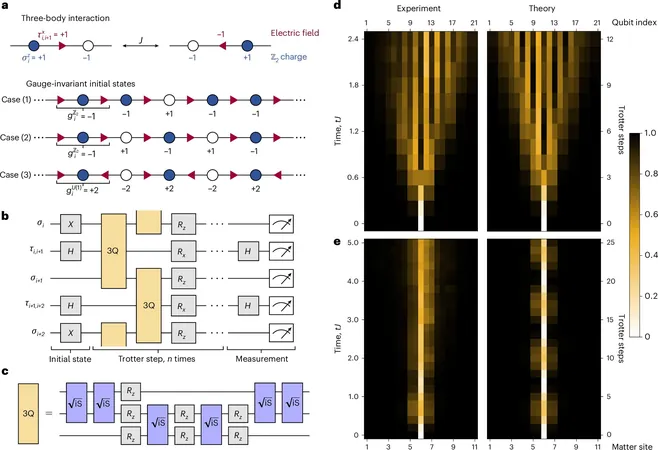
Breakthrough in Quantum Computing Paves the Way for Advances in Lattice Gauge Theory!
2025-01-13
Author: Amelia
Breakthrough in Quantum Computing Paves the Way for Advances in Lattice Gauge Theory!
In the relentless pursuit of more powerful computational tools, scientists are turning their sights toward quantum computers—innovative machines that leverage the principles of quantum mechanics to tackle some of the most complex problems in physics. Thanks to their unique capabilities involving quantum superposition and entanglement, these computers represent a significant leap forward in data processing.
A cutting-edge research team from the University of Trento’s Department of Physics has recently made headlines by exploring crucial questions in lattice gauge theory using quantum computing technologies at Google's Quantum Artificial Intelligence Lab in California. Their findings were published in the prestigious journal *Nature Physics*, marking a significant milestone in the field.
Gauge theories are foundational frameworks in particle physics, helping to describe the fundamental forces that govern our universe. These theories are vital not only for particle physics but also for the condensed matter sector, as they explain complex interactions among charged particles and electromagnetic fields. Despite their importance, certain phenomena governed by local gauge constraints remain poorly understood. This is where quantum simulators come into play, offering unprecedented insights that traditional computers simply cannot achieve.
The research led by Professor Philipp Hauke at UniTrento is noteworthy—especially since the university was one of only eight winners from around the globe during Google’s 2019 call for projects aimed at exploring the potential of quantum computing. Notably, it was the sole institution selected from the entire European Union.
Professor Hauke and his team tackled a pivotal question concerning the interactions of elementary particles, particularly within the framework of lattice gauge theory—which involves discretizing continuous spacetime into a hypercubic lattice. This concept is critical for understanding how particles like electrons, positrons, and potentially quarks and gluons interact to form the building blocks of matter.
The researchers designed a specialized algorithm that was executed on Google’s quantum supercomputers in Santa Barbara. These state-of-the-art machines exploit quantum principles to model complex quantum objects with a sophistication that classical computers, which operate on mere binary bits (0s and 1s), cannot replicate.
To illustrate the sheer potential of quantum computing, Professor Hauke explains, “Traditional instruments can only accurately model the dynamics of systems containing up to 40 particles. In contrast, quantum computers can exponentially manage a much larger number. However, achieving this requires collaboration at the crossroads of fundamental physics and advanced engineering—not a simple feat, but one that our research aims to navigate.”
This breakthrough paves the way not only for a deeper understanding of particle interactions but could also revolutionize numerous fields where computational power is crucial, including material science, cryptography, and complex system simulations. As this area of research progresses, we may just be scratching the surface of what quantum computing can ultimately achieve.
Stay tuned—this could be just the beginning of a quantum revolution in science!



 Brasil (PT)
Brasil (PT)
 Canada (EN)
Canada (EN)
 Chile (ES)
Chile (ES)
 Česko (CS)
Česko (CS)
 대한민국 (KO)
대한민국 (KO)
 España (ES)
España (ES)
 France (FR)
France (FR)
 Hong Kong (EN)
Hong Kong (EN)
 Italia (IT)
Italia (IT)
 日本 (JA)
日本 (JA)
 Magyarország (HU)
Magyarország (HU)
 Norge (NO)
Norge (NO)
 Polska (PL)
Polska (PL)
 Schweiz (DE)
Schweiz (DE)
 Singapore (EN)
Singapore (EN)
 Sverige (SV)
Sverige (SV)
 Suomi (FI)
Suomi (FI)
 Türkiye (TR)
Türkiye (TR)
 الإمارات العربية المتحدة (AR)
الإمارات العربية المتحدة (AR)